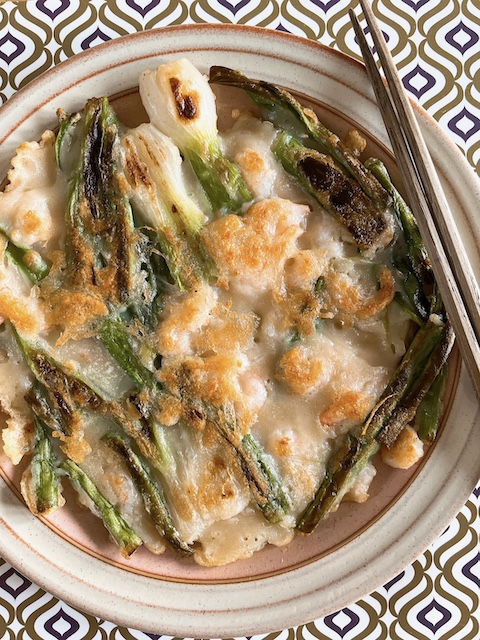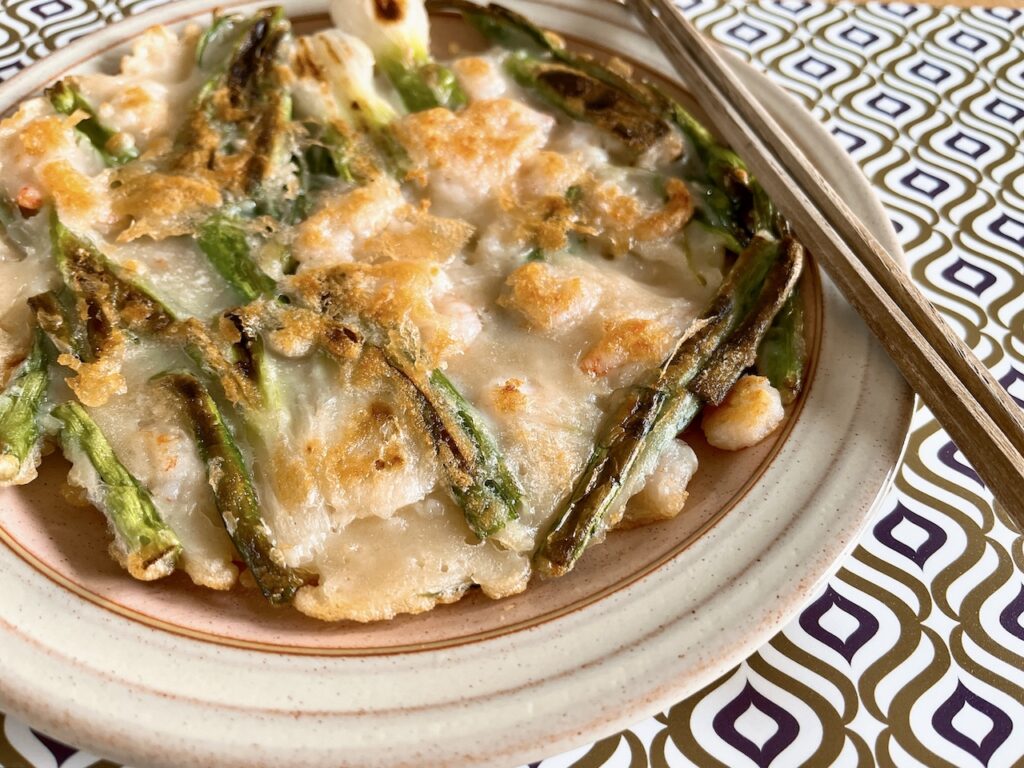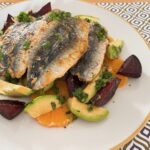I’ve been trying to cook this Korean scallion pancake many times since I read it in Rice Table, a Korean cookbook. But I didn’t like the output so much, and some steps seem not necessary to me, so I kept on looking for a better recipe.
And somehow, I was trapped into a world of flour and starch. Which one should I use actually? Can it be substitute? Is A really better than B? Many whys happened.
After numerous trial and error, I landed on a solid Korean scallion recipe that suits my taste, and with the know-how behind. I’ve organised my thoughts and experience in this blog post. Hopefully it helps.
Now, if you can spare a moment, watch below videos to have an idea of how to cook Korean scallion pancake with seafood (Haemul Pajeon).
Table of Contents
- Korean Scallion Pancake Cooking Videos
- Some Useful Cooking Notes
- Korean Scallion Pancake with Seafood Recipe

Korean Scallion Pancake Cooking Videos
These two are very popular Korean recipe bloggers. Let’s see how do they make this pancake!
Ref video 1: Maangchi
Plain flour plus 1 tbsp potato starch. No ice cold water. Coat the scallions with batter first.
Ref video 2: Korean Bapsang
Use ready-mixed flour, (or this). Use ice cold water. Throw the scallions into the batter.
Some Useful Cooking Notes
It may take a minute, but I encourage you to read these before you cook. A delicious and crispy pancake worths a minute of reading.
Is ice cold water a must?
Principally, cold temperature slows the formation of gluten during the cooking process. Gluten offers chewiness, like in bread, so you don’t want too much of it in this pancake. To me, ice cold water is not a must. If the oil is hot enough, I can make a crispy pancake, too!
Some people place the batter in the fridge for a few hours before cooking, and the theory is the same.
Potato starch or corn starch?
Short answer: both are fine. I tested both, the outcome were very similar that I can’t tell the difference. In Japan, people use potato starch (片栗粉 ka-ta-ku-ri-ko) in this kind of pancakes, like this recipe.
If you want to dig deeper, read this article — it explains how starch works and why.
Can I use rice flour?
You may well know rice flour fry up crispier than wheat flour, and it often used in tempura. I also tried the combination of rice flour with corn starch, which turned out, sadly, it’s too hard. It’s because rice flour is gluten-free, and we do some chewiness in the pancake. That’s said, a combination of plain flour and rice flour is not a bad idea! I tried using half of each, and it was great.
Add egg or not?
To me, it’s purely for flavour, and I like my pancake without egg.
The batter should be runny
That’s how you get a thin pancake, and thin pancake means one more thing — crispy!
The scallion white is delicious!
If you see a bunch of fresh salad scallion which white part is big and shiny, buy it! When it is charred nicely, you’ll be surprised how sweet and creamy it is!
Don’t skim on oil
Fry food tastes better. We all know that. This kind of pancake requires a generous amount of oil. You also understand that, right?

Korean Scallion Pancake with Seafood Recipe
Ingredients
Makes a ⌀20cm pancake
- 50 g plain flour
- 20 g potato starch or cornflour (corn starch)
- ¼ tsp salt
- ⅛ tsp baking powder (not a must)
- 100 g water (preferably ice cold)
- 50 g seafood (mix is good)
- 60 g scallions
How to Make
- Use the whole scallion and cut it into a finger long. If the white bottom part is too big, slice it lengthwise to flatten it out. Chop the seafood into bite size. If using frozen, thaw in advance and pat dry.
- Mix the flour, starch, salt and baking powder (if using) in a bowl and mix. Make a well in the centre, gradually pour in the water while stirring continuously. This helps forming a smooth batter without lumps.
- Add the scallions and seafood into the batter and mix again.
- Heat enough oil to just coat the pan’s bottom. Pour in the batter and quickly swirl the pan to distribute evenly.
- When the edge starts to brown, flip to the other side, lift up the edge again and add a little more oil, then swirl the pan again.
- Cook until both sides are golden brown with some chars on the scallions. Serve with a simple sauce of soy sauce and vinegar (1:1 ratio).


